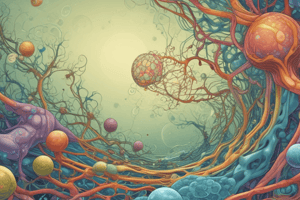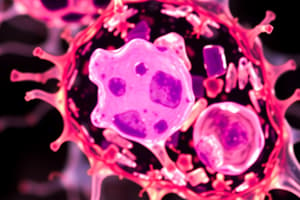Podcast
Questions and Answers
What is the former name for cell biology?
What is the former name for cell biology?
Cytology
What is the term for the primary or essential substance containing a nucleus?
What is the term for the primary or essential substance containing a nucleus?
Protoplasm
What are the two basic plans of cellular organization?
What are the two basic plans of cellular organization?
- Prokaryotes and Eukaryotes (correct)
- Somatic cells and Gametes
- Unicellular and Multicellular
- Plant cells and Animal cells
Which of the following is NOT a characteristic of prokaryotes?
Which of the following is NOT a characteristic of prokaryotes?
Match the following cell structures with their primary function in the cell:
Match the following cell structures with their primary function in the cell:
Plant cells contain chloroplasts for photosynthesis.
Plant cells contain chloroplasts for photosynthesis.
Which of the following is NOT a component of the cell's outer membrane?
Which of the following is NOT a component of the cell's outer membrane?
What is the main component of the plasma membrane and what is it composed of?
What is the main component of the plasma membrane and what is it composed of?
Which type of transport requires energy?
Which type of transport requires energy?
Which of the following is NOT a type of passive transport?
Which of the following is NOT a type of passive transport?
What is the role of transmembrane proteins in facilitated diffusion?
What is the role of transmembrane proteins in facilitated diffusion?
What type of transport is used to move large particles into the cell?
What type of transport is used to move large particles into the cell?
Pinocytosis is a type of endocytosis that involves the uptake of fluids.
Pinocytosis is a type of endocytosis that involves the uptake of fluids.
Exocytosis is a process where materials are moved out of the cell.
Exocytosis is a process where materials are moved out of the cell.
Flashcards
Cell Biology
Cell Biology
The study of cells, their structure, function, interactions, division, and death.
Cell Theory
Cell Theory
All living organisms are composed of cells, cells are the basic unit of structure and function in living organisms, and new cells arise from pre-existing cells.
Prokaryotes
Prokaryotes
Cells that lack a nucleus and other membrane-bound organelles, typically smaller and simpler than eukaryotes.
Eukaryotes
Eukaryotes
Signup and view all the flashcards
Cell Membrane
Cell Membrane
Signup and view all the flashcards
Cytoplasm
Cytoplasm
Signup and view all the flashcards
Nucleus
Nucleus
Signup and view all the flashcards
Endoplasmic Reticulum (ER)
Endoplasmic Reticulum (ER)
Signup and view all the flashcards
Golgi Apparatus
Golgi Apparatus
Signup and view all the flashcards
Lysosomes
Lysosomes
Signup and view all the flashcards
Vacuoles
Vacuoles
Signup and view all the flashcards
Mitochondria
Mitochondria
Signup and view all the flashcards
Cytoskeleton
Cytoskeleton
Signup and view all the flashcards
Cell Wall
Cell Wall
Signup and view all the flashcards
Chloroplasts
Chloroplasts
Signup and view all the flashcards
Passive Transport
Passive Transport
Signup and view all the flashcards
Facilitated Diffusion
Facilitated Diffusion
Signup and view all the flashcards
Active Transport
Active Transport
Signup and view all the flashcards
Bulk Transport
Bulk Transport
Signup and view all the flashcards
Exocytosis
Exocytosis
Signup and view all the flashcards
Endocytosis
Endocytosis
Signup and view all the flashcards
Pinocytosis
Pinocytosis
Signup and view all the flashcards
Phagocytosis
Phagocytosis
Signup and view all the flashcards
Organelles
Organelles
Signup and view all the flashcards
Manufacturing in Cells
Manufacturing in Cells
Signup and view all the flashcards
Breakdown of Molecules
Breakdown of Molecules
Signup and view all the flashcards
Energy Processing
Energy Processing
Signup and view all the flashcards
Structural Support, Movement, and Communication
Structural Support, Movement, and Communication
Signup and view all the flashcards
Phospholipid Bilayer
Phospholipid Bilayer
Signup and view all the flashcards
Study Notes
Cell Biology
- Cell biology, formerly called cytology, is a branch of biology.
- It studies cells, their physiological properties, structure, interactions with their environment, division, function, and death.
- This study is conducted at both the microscopic and molecular levels.
Cell Theory
- Proposed by Matthias Schleiden, Theodor Schwann, and Rudolf Virchow.
- All living things are made up of cells.
- Cells are the basic units of structure and function in an organism.
- New cells are produced from existing cells.
- Schleiden (1838): All plants are made of cells.
- Schwann (1839): All animals are made of cells.
- Virchow (1855): All cells come from pre-existing cells.
Cellular Organization
- Early studies described cells as consisting of protoplasm (essential substance) containing a nucleus and surrounded by a membrane (cell/plasma membrane).
- The protoplasm surrounding the nucleus is called cytoplasm, and the nucleus's protoplasm is called nucleoplasm.
- Electron microscopy (EM) revealed two fundamental cell types:
- Prokaryotes (before nucleus): simpler, without a nuclear envelope or compartmentalization.
- Eukaryotes (true nucleus): more complex, with a nuclear envelope and organelles.
Prokaryotes vs. Eukaryotes
| Feature | Prokaryote | Eukaryote |
|---|---|---|
| Size of cell | Typically 0.2-2.0 µm in diameter | Typically 10-100 µm in diameter |
| Nucleus | No nuclear membrane or nucleolus | True nucleus with nuclear membrane and nucleolus |
| Organelles | Absent | Present; examples include lysosomes, Golgi complex, endoplasmic reticulum, mitochondria, and chloroplasts |
| Flagella | Consist of two protein building blocks | Complex; consists of multiple microtubules |
| Glycocalyx | Present as a capsule or slime layer | Present in some cells that lack a cell wall |
| Cell Wall | Usually present; chemically complex; examples include peptidoglycan in bacterial cell walls, or cellulose or chitin in plants | Usually present; chemically complex in plants, some protists, fungi |
| Plasma Membrane | No carbohydrates and generally lacks sterols | Sterols and carbohydrates that can serve as receptors |
| Cytoplasm | No cytoskeleton or cytoplasmic streaming | Cytoskeleton; cytoplasmic streaming |
| Ribosomes | Smaller size (70S) | Larger size (80S); smaller size (70S) in organelles |
| Chromosome (DNA) | Usually single circular chromosome; typically lacks histones | Multiple linear chromosomes with histones |
| Cell Division | Binary fission | Involves mitosis |
| Sexual Recombination | None; transfer of DNA only | Involves meiosis |
Cell Structure and Functions
- Specific cellular structures and functions*:
| Structure | Function |
|---|---|
| Nucleus | DNA synthesis, RNA synthesis, assembly of ribosomal subunits; contains chromosomes and nucleolus |
| Ribosomes | Protein synthesis |
| Rough ER | Synthesis of membrane lipids and proteins; packaging of proteins in vesicles for transport |
| Smooth ER | Lipid synthesis; detoxification in liver cells; calcium ion storage; modification and transport of macromolecules |
| Golgi apparatus | Modification and transport of macromolecules; formation of lysosomes and transport vesicles |
| Lysosomes | Digestion of ingested food, bacteria, damaged organelles, macromolecules; recycling materials |
| Vacuoles | Digestion; storage of chemicals; cell enlargement; water balance |
| Peroxisomes | Metabolic processes, breakdown of H2O2 |
| Mitochondria | Conversion of chemical energy of food to chemical energy of ATP |
| Chloroplasts | Conversion of light energy to chemical energy of sugars |
-
Cell support, movement, and communication*:
-
Cytoskeleton: maintains cell shape, anchors organelles, aids in movement, and transmits signals
-
Extracellular matrix: binding of cells in tissues, surface protection, and regulation of cellular activities
-
Cell junctions: cell communication and tissue integrity
-
Cell walls: maintenance of cell shape for structure and protection, and interaction between cells
Cell (Plasma) Membrane
- Composed of a mix of proteins and lipids.
- Lipids include phospholipids and cholesterol, forming a phospholipid bilayer.
- Proteins include integral (penetrate the bilayer) and peripheral (on surfaces) proteins.
- Carbohydrates (oligosaccharides) are attached to proteins (glycoproteins) or lipids (glycolipids), acting as receptors and recognition molecules.
Transport Across Membranes
- The cell membrane regulates material exchange.
- Passive Transport: Movement down a concentration gradient; includes diffusion (small molecules like CO2 and H2O), and facilitated diffusion (large molecules via transmembrane proteins).
- Active Transport: Movement against a concentration gradient; requires energy and transmembrane proteins.
- Bulk Transport: Movement of large particles; includes endocytosis (into cell—pinocytosis for fluids, phagocytosis for solids) and exocytosis (out of cell).
Studying That Suits You
Use AI to generate personalized quizzes and flashcards to suit your learning preferences.
Related Documents
Description
This quiz covers the essential concepts of cell biology, including its definition and historical context. It delves into cell theory, which highlights the foundational principles regarding the structure and function of cells. Additionally, it explores cellular organization and the composition of cells.




